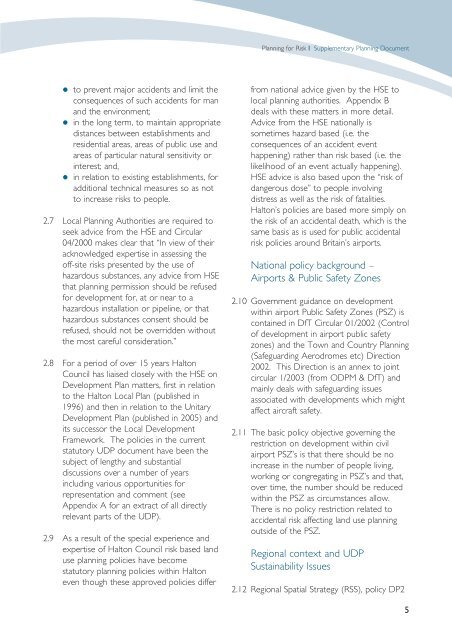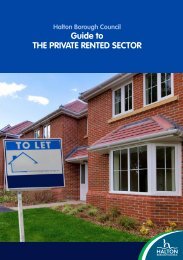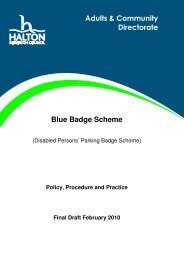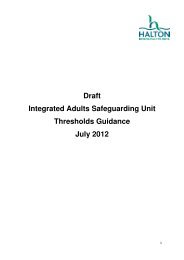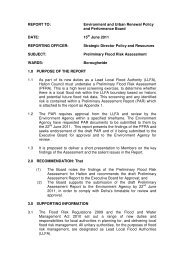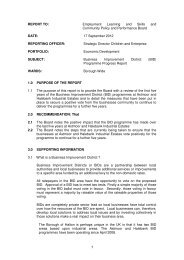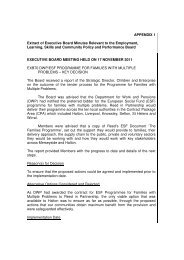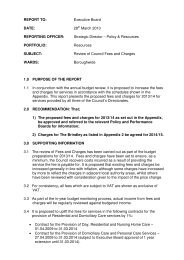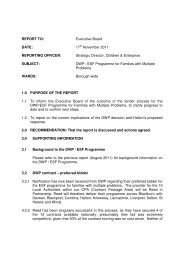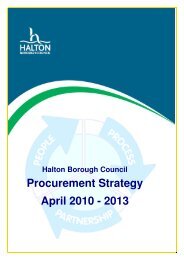Planning for Risk SPD:Layout 1.qxd - Halton Borough Council
Planning for Risk SPD:Layout 1.qxd - Halton Borough Council
Planning for Risk SPD:Layout 1.qxd - Halton Borough Council
You also want an ePaper? Increase the reach of your titles
YUMPU automatically turns print PDFs into web optimized ePapers that Google loves.
<strong>Planning</strong> <strong>for</strong> <strong>Risk</strong> I Supplementary <strong>Planning</strong> Document<br />
to prevent major accidents and limit the<br />
consequences of such accidents <strong>for</strong> man<br />
and the environment;<br />
in the long term, to maintain appropriate<br />
distances between establishments and<br />
residential areas, areas of public use and<br />
areas of particular natural sensitivity or<br />
interest; and,<br />
in relation to existing establishments, <strong>for</strong><br />
additional technical measures so as not<br />
to increase risks to people.<br />
2.7 Local <strong>Planning</strong> Authorities are required to<br />
seek advice from the HSE and Circular<br />
04/2000 makes clear that “In view of their<br />
acknowledged expertise in assessing the<br />
off-site risks presented by the use of<br />
hazardous substances, any advice from HSE<br />
that planning permission should be refused<br />
<strong>for</strong> development <strong>for</strong>, at or near to a<br />
hazardous installation or pipeline, or that<br />
hazardous substances consent should be<br />
refused, should not be overridden without<br />
the most careful consideration.”<br />
2.8 For a period of over 15 years <strong>Halton</strong><br />
<strong>Council</strong> has liaised closely with the HSE on<br />
Development Plan matters, first in relation<br />
to the <strong>Halton</strong> Local Plan (published in<br />
1996) and then in relation to the Unitary<br />
Development Plan (published in 2005) and<br />
its successor the Local Development<br />
Framework. The policies in the current<br />
statutory UDP document have been the<br />
subject of lengthy and substantial<br />
discussions over a number of years<br />
including various opportunities <strong>for</strong><br />
representation and comment (see<br />
Appendix A <strong>for</strong> an extract of all directly<br />
relevant parts of the UDP).<br />
2.9 As a result of the special experience and<br />
expertise of <strong>Halton</strong> <strong>Council</strong> risk based land<br />
use planning policies have become<br />
statutory planning policies within <strong>Halton</strong><br />
even though these approved policies differ<br />
from national advice given by the HSE to<br />
local planning authorities. Appendix B<br />
deals with these matters in more detail.<br />
Advice from the HSE nationally is<br />
sometimes hazard based (i.e. the<br />
consequences of an accident event<br />
happening) rather than risk based (i.e. the<br />
likelihood of an event actually happening).<br />
HSE advice is also based upon the “risk of<br />
dangerous dose” to people involving<br />
distress as well as the risk of fatalities.<br />
<strong>Halton</strong>’s policies are based more simply on<br />
the risk of an accidental death, which is the<br />
same basis as is used <strong>for</strong> public accidental<br />
risk policies around Britain’s airports.<br />
National policy background –<br />
Airports & Public Safety Zones<br />
2.10 Government guidance on development<br />
within airport Public Safety Zones (PSZ) is<br />
contained in DfT Circular 01/2002 (Control<br />
of development in airport public safety<br />
zones) and the Town and Country <strong>Planning</strong><br />
(Safeguarding Aerodromes etc) Direction<br />
2002. This Direction is an annex to joint<br />
circular 1/2003 (from ODPM & DfT) and<br />
mainly deals with safeguarding issues<br />
associated with developments which might<br />
affect aircraft safety.<br />
2.11 The basic policy objective governing the<br />
restriction on development within civil<br />
airport PSZ’s is that there should be no<br />
increase in the number of people living,<br />
working or congregating in PSZ’s and that,<br />
over time, the number should be reduced<br />
within the PSZ as circumstances allow.<br />
There is no policy restriction related to<br />
accidental risk affecting land use planning<br />
outside of the PSZ.<br />
Regional context and UDP<br />
Sustainability Issues<br />
2.12 Regional Spatial Strategy (RSS), policy DP2<br />
5


